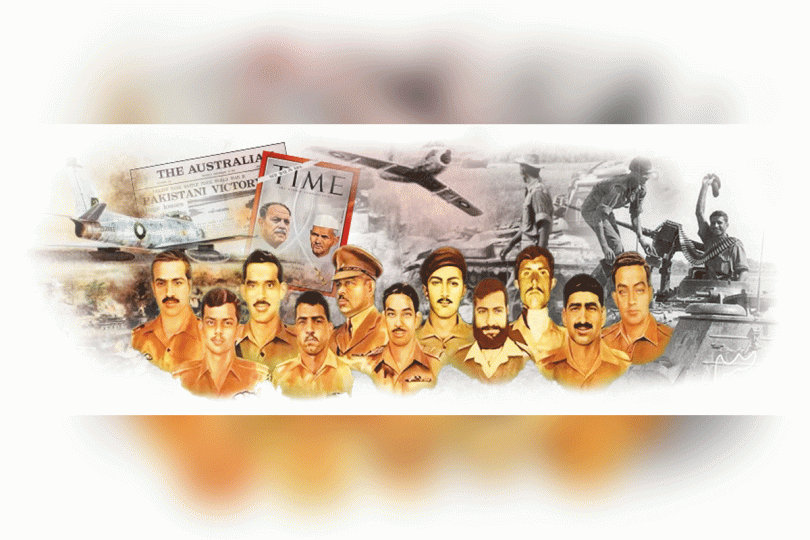Despite producing great content, not all Defence Day projects hit the bullseye!
Pakistan Television and Pakistani filmmakers have been an integral part of the Defence Day celebrations in the country. Ever since the 1965 War, when many soldiers gave their lives to save their motherland, both PTV and filmmakers have tried their best to pay tribute to the brave sons of the soil. Sometimes they have immortalised the heroes, and sometimes recreated the entire mission flawlessly, but on every occasion, the audience has been left mesmerised.
BOLD takes the audience down memory lane to celebrate such projects that have managed to stay fresh in the audience’s minds because of their near-perfect execution. We will also celebrate those projects that were made with the best of intentions but were unable to hit the bullseye, resulting in attempts that could have been saved with better execution. Read about the hits and misses, and then re-watch those you might have missed.
What Nishan-e-Haider started is still going strong!
During the 1980s, three long plays in the Nishan-e-Haider series were aired on PTV and each of them proved to be better than the previous one. The series that kicked off with Major Raja Sarwar Shaheed (played by Saleem Nasir) was followed by Major Tufail Mohammad Shaheed (Zille Subhan) and Pilot Officer Rashid Minhas (Pilot Officer Farooq Iqbal) and all three are still remembered after nearly four decades. PTV did try to breathe life back into the series in the late ‘90s with Major Raja Aziz Bhatti (Nasir Sherazi), but despite being a well-executed attempt, it couldn’t revive the series.


The first two dramas were made in the style of big-budget Hollywood flicks where the most good-looking actors were selected to play army officers, while the third and fourth plays depended on their excellent script and direction. In fact, the audience still remembers the resemblance Zille Subhan and Nasir Sherazi shared with the people they were playing on screen, so much so that some even forgot that they were actors playing those characters. Add to that the excellently choreographed war sequences and morale-boosting speeches and the viewers had everything they could wish for.
It was also during the 1980s that PTV aired a long play Rishtay Aur Rastay that was based on the creation of the Karakoram Highway. Directed by Bakhtiar Ahmed on an idea presented by Obaid Ullah Baig and Kunwar Aftab Ahmed, and scripted by Taj Haider, it revolved around the life of an army officer (Behroze Sabzwari) who goes to China as an exchange student and falls in love with a local student, who returns as the wife of his counterpart when the Army sends him to look after the construction of the Karakoram Highway. Not only was the play a huge success, but it was also shot partly in China which was a huge thing back in those days.
No document would be complete without the mention of Sunehrey Din, and its direct or indirect sequels. For 30 years, it has kept Faraz Inam in the spotlight, who debuted with a play that raised the bar for military dramas. Being the first of the many TV series that followed, the play had Saleem Sheikh as a youngster who defied his mother by going into the Army and then had the experience of a lifetime. This play was a mixture of both comedy and military tradition, and also introduced the Pakistani audience to Gulsher (Captain Qasim Khan) and Kashif (Captain Abdullah) besides Faraz, who were later the lead characters of Shoaib Mansoor’s Alpha Bravo Charlie.


While Sunehray Din was based on literary classics such as Colonel Ashfaq Hussain’s Gentleman Alhumdulillah and Brigadier Saulat Raza’s Kakooliat, Alpha Bravo Charlie was entirely a Shoaib Mansoor project. And then there was Ehd-e-Wafa which featured the now Brigadier Faraz’s son (Asif Raza Mir) and his three friends (Osman Khalid Butt, Ahmad Ali Akbar, and Wahaj Ali) who study together and then become friends for life. While the Saife Hasan-directed play didn’t just revolve around the Army, its spin-off Sinf-e-Aahan did which highlighted the transformation of female cadets into officers.
The drama which aired last year had an ensemble cast featuring Sajal Aly, Yumna Zaidi, Kubra Khan, Ramsha Khan, and Syra Yousuf, and was appreciated for its positive portrayal of female cadets and officers. But the long play Ek Hai Nigar which came out a few months before Sinf-e-Aahan stood out as Mahira Khan played Lieutenant General Nigar Johar, Pakistan Army’s first and only woman to reach that rank. Not only did the long play pay tribute to the wonderful doctor but it also won awards abroad for its brilliant storyline and production.
PAF and Navy came to the party late, but did good work!
Although Pakistan Air Force and Pakistan Navy weren’t as active in the beginning, they entered with a bang through Mustansar Hussain Tarar’s Shehpar which revolved around the lives of three cadets who each had a different story to tell. Faisal Rehman’s performance as the Tom Cruise-ish Fighter Pilot was appreciated and the same could be said about the amazing aerial shots that were directed by Qaiser Farooq and Syed Shakir Uzair, in collaboration with the PAF. A decade later, Haseeb Hasan’s Sher Dil recreated the same magic but revolved more around the lives of cadets than the actual flying. It was also the first ISPR project done in collaboration with a private TV channel, opening the gate for future collaboration.


One must also mention the two landmark PTV long plays – Ghazi Shaheed and Operation Dwarka – that helped Pakistan Navy enter the arena in an emphatic way. Both the plays had an ensemble cast and revolved around real-life incidents and although one was a triumphant mission, the other ended in a tragedy that was captured well on screen. Lately, Haseeb Hasan’s Laal, also made its presence felt where Bilal Abbas Khan played the role of a cadet who defies odds to achieve his goals and make his country proud.
Trendsetting films Khuda Ke Liye, Waar must be given their due credit!
Pakistan Army’s contribution to the revival of Pakistani cinema can never be forgotten since they were behind two of its most influential projects in the last 15 years. First, they brought people back into the cinemas with Khuda Ke Liye in 2007 which consolidated Shoaib Mansoor’s vision as one for the future. Then they went ahead and gave the audience Waar in 2013, a film with such impressive action sequences and aerial shots that it made Bollywood look like a smaller industry. Sadly, the films that followed these two films weren’t able to recreate the magic, but if Khuda Ke Liye and Waar are played in cinemas today, the audience would leave everything aside and watch these classics, which wouldn’t have been possible without the Armed Forces’ support.
The missing list shockingly features two PAF collaborations!
It took the Pakistan Air Force fifty years to make a feature film about the airmen of the country, and while their intentions were commendable, their decision to greenlight Parwaaz Hai Junoon and Sherdil seemed haphazard. While Parwaaz Hai Junoon was supposed to be PAF’s comeback vehicle after Qasam Us Waqt Ki in 1969, constant changes to the cast as well as the director didn’t help the film at all.
Instead of asking the more experienced ISPR for guidance, they chose to go ahead with the project which resulted badly. While the Hamza Ali Abbasi-Hania Aamir starrer did decent business at the box office and is amongst the most successful films ever produced in the country, it was any decent critic’s worst nightmare. The premiere in Karachi was cancelled abruptly, while the manner in which the story was executed seemed childish.


Similarly, Azfar Jafri’s Sherdil was marred by problems of its own, which included the feud between the producer Noman Khan and the leading actress Armeena Khan, which resulted in the producer’s own teenage daughter dubbing for the heroine, that too when she had a small cameo in the movie. Despite having some of the greatest aerial sequences shot in Pakistan – thanks to technicians from abroad – Sherdil bombed at the box office because it had nothing to offer.
Recently, two patriotic films featuring Humayun Saeed bombed big time at the box office, which is surprising considering most of his films turn out to be blockbusters. The first of these films was Yalghaar that was the directorial debut of Hasan Waqas Rana, the writer of Waar, and featured an ensemble cast, ranging from Shaan Shahid, Bilal Ashraf, Adnan Siddiqui, Humayun Saeed to Ayesha Omer, Armeena Khan, Sana Bucha and Aleeze Nasser. The story may have revolved around the Swat Operation but couldn’t deliver despite the presence of the stars and was more of a wasted opportunity than a proper action flick.
Humayun Saeed, who played the antagonist in Yalghaar, returned to the good guy role in Project Ghazi, but that didn’t change the result. What was supposed to be a science fiction flick turned out to be a low-budget action film where Sheheryar Munawwar played a Super Soldier who wanted to avenge his father’s death. The film first premiered in 2017 but was immediately recalled when people at the event were shocked to see an incomplete project. Its release more than a year later was better but it didn’t hit the audience as it should have.


And then there were Saya-e-Khuda-e-Zuljalal and Kaaf Kangana, the two films that could have done much better had they been handed over to experienced campaigners. Directed by first-time filmmaker Umair Fazli, Saya-e-Khuda-e-Zuljalal was an ambitious project that depended heavily on the popularity of its historical characters like Quaid-e-Azam Mohammad Ali Jinnah, Major Shabbir Sharif, Major Aziz Bhatti, among others. It even had a breathtaking aerial dogfight sequence and some hand-to-hand combat but the non-linear timeline appeared to confuse the audience.
On the other hand, Kaaf Kangana was renowned script writer Khalil ur Rehman Qamar’s debut project as a director and although it was supposed to be a love story that transcends borders, it turned out to be a spoof of films like Tere Pyar Main and Veer–Zaara. Despite having Sami Khan in the lead with newcomer Eshal Fayyaz, and a brilliant soundtrack, it bombed at the box office because of its inexperienced execution.
TV also had its share of disappointments too, but they were fewer in number!
After the success of Nishan-e-Haider’s play based on the martyrdom of Major Raja Aziz Bhatti, PTV did try to resurrect the series but couldn’t repeat the success. The play revolving around Lance Naik Mohammad Mehfooz was aired on national TV but was never heard of again. It had Captain Aun Naqvi playing the title character while veteran director Bakhtiar Ahmed was behind the script and execution, but with PTV losing its audience to cable TV, it wasn’t surprising that the long play didn’t register with the audience.
However, ISPR did try to come up with a miniseries regarding the brave Prisoner of War Sipahi Maqbool Hussain, who spent 4 decades in Indian military jails but didn’t divulge any information about the Pakistan Army. The biggest issue with this series where Hassan Niazi played the title character was going for a channel that wasn’t top-notch and selecting a cast that not many knew. Maqbool Hussain was awarded the Sitara-e-Jurrat for his refusal to oblige his captors for 40 years, and Hassan Niazi’s performance would have been appreciated more had the play been aired on mainstream media.
Director Sarmad Khoosat’s Ek Thi Marium also paid tribute to PAF’s first female fighter pilot to achieve martyrdom, but it didn’t turn out the way it should have. Despite Sanam Baloch’s brilliant performance and some high-quality aerial sequences, the play was subpar compared to PAF’s earlier offerings. The climax might have left many teary-eyed, but using creative license instead of special effects was a bad idea, and that’s why the play ranks after Nishan-e-Haider long plays Pilot Officer Rashid Minhas Shaheed and Shehpar that were aired decades back.

And then there was Saqib Khan’s long play Hangor which revolved around the successful mission of PNS Hangor, the first submarine to have a recorded kill after the Second World War. It would have been great had Saji Gul’s script been linear instead of taking the audience between past and present, and that killed all the excitement of an underwater adventure.
Featuring Zahid Ahmed and Shehzad Sheikh as submarine officers, and Saba Qamar and Durre Shehwar as their love interests, it had a lot to offer but it couldn’t deliver. Even the historic kill looked low-quality, especially for that audience who grew up watching Hollywood flicks like The Hunt for Red October, Crimson Tide and many others. The loopholes in the script confused the viewers and left more questions than answers in the minds of those who had no idea what Hangor was.







